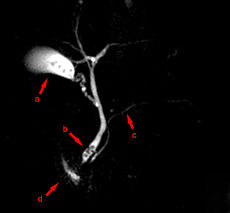- Magnetic resonance cholangiopancreatography
-
Magnetic resonance cholangiopancreatography Intervention 
MRCP image showing stones in the distal common bile duct: (a) Gallbladder with stones (b) Stone in bile duct (c) Pancreatic duct (d) Duodenum.ICD-9-CM 88.97 MeSH D049448 OPS-301 code: 3-843 Magnetic resonance cholangiopancreatography (MRCP) is a medical imaging technique that uses magnetic resonance imaging to visualise the biliary and pancreatic ducts in a non-invasive manner.[1] This procedure can be used to determine if gallstones are lodged in any of the ducts surrounding the gallbladder.
It was introduced in 1991.[2]
Comparison to other techniques
In the diagnosis of biliary and pancreatic disorders, MRCP is a much less invasive investigation when compared to endoscopic retrograde cholangiopancreatography (ERCP). Although both techniques can image the ductal system in detail, MRCP also allows imaging of the surrounding parenchyma. In a recent study of 269 patients undergoing both ERCP and MRCP, the MRCP compared favourably with the more invasive technique.[3] As with other forms of Magnetic Resonance imaging, appearances can sometimes be deceptive.[4]
References
- ^ Prasad, SR; D. Sahani, S. Saini (2001-11). "Clinical applications of magnetic resonance cholangiopancreatography.". Journal of Clinical Gastroenterology 33 (5): 362–6. PMID 11606850.
- ^ Albert L. Baert (13 February 2008). Encyclopedia of Diagnostic Imaging. Springer. pp. 123–. ISBN 9783540352785. http://books.google.com/books?id=e3F4NaY3fgQC&pg=PA123. Retrieved 3 July 2011.
- ^ Hekimoglu K, Ustundag Y et al. MRCP vs. ERCP in the evaluation of biliary pathologies: review of current literature. J Dig Dis. 2008 Aug;9(3):162-9.[1]
- ^ Jordan AN, Kodati S, Zeki S. A deceptive magnetic resonance cholangiopancreatogram? Grand Rounds 10:25-27; 2010, [2]
Medical testing : Medical imaging · Radiology · (ICD-9-CM V3 87-88, ICD-10-PCS B, CPT 70010-79999) X-ray/
medical radiography/
Industrial radiographyMedical: Pneumoencephalography · Dental radiography · Sialography · Myelography · CXR (Bronchography) · AXR / KUB · DXA/DXR · Upper gastrointestinal series/Small bowel follow-through/Lower gastrointestinal series · Cholangiography/Cholecystography · Mammography · Pyelogram · Cystography · Arthrogram · Hysterosalpingography · Skeletal survey · Angiography (Angiocardiography, Aortography) · Venography · Lymphogram
Industrial: Radiographic testingMedical: CT pulmonary angiogram · Cardiac CT · Abdominal and pelvic CT (Virtual colonoscopy) · CT angiography · CT head · pQCT · Spiral computed tomography · High resolution CT · Whole body imaging (Full-body CT scan) · Electron beam tomography
Industrial: Industrial CT ScanningOtherMRI MRI of brain and brain stem · MR neurography · Cardiac MRI/Cardiac MRI perfusion · MR angiography · MR cholangiopancreatography · Breast MRI
Functional MRI · Diffusion MRIUltrasound Echocardiography / Doppler echocardiography (TTE · TEE) · Intravascular · Gynecologic · Obstetric · Echoencephalography · Transcranial doppler · Abdominal ultrasonography · Transrectal · Breast ultrasound · Transscrotal ultrasound · Carotid ultrasonography
Contrast-enhanced · 3D ultrasound · Endoscopic ultrasound · Emergency ultrasound (FAST) · DuplexRadionuclide 2D / scintigraphyCholescintigraphy · Scintimammography · Ventilation/perfusion scan · Radionuclide ventriculography · Radionuclide angiography · Radioisotope renography · Sestamibi parathyroid scintigraphy · Radioactive iodine uptake test · Bone scintigraphy · Immunoscintigraphy
full body: Octreotide scan · Gallium 67 scan · Indium 111 WBC scan3D / ECTSPECT (gamma ray): SPECT of brain, Myocardial perfusion imaging
PET (positron): Brain PET, Cardiac PET, PET mammography, PET-CTOptical laser Thermography Breast thermography
This article related to medical equipment is a stub. You can help Wikipedia by expanding it.
